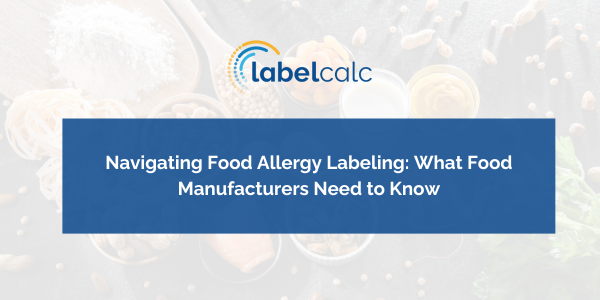Understanding food allergen rules and requirements is essential for food manufacturers to ensure consumer safety and avoid costly regulatory violations.
There are nine specific allergens that must be declared in any products regulated by the U.S. Food and Drug Administration.
Initially, the Food Allergen Labeling and Consumer Protection Act of 2004 (FALCPA) named eight major food allergens that required mandatory labeling. The Food Allergy Safety, Treatment, Education, and Research Act – also known as the FASTER Act – added a ninth, sesame.
There is no “de minimis” level for defined allergens under FDA regulations, says Tracy Herb, Sr. Product Manager at LabeCalc. So, no matter how little of an ingredient in the finished product, it must be declared on the label.
Food manufacturers are required to include the following allergens on their food labels:
- Eggs (specify if not hen’s eggs*)
- Peanuts
- Milk (specify if not cow’s milk*)
- Tree nuts (specify types of nuts*)
- Soy
- Wheat
- Fish (specify types of fish*)
- Crustaceans (specify types of crustaceans*)
- Sesame
The regulations were updated again on January 6, 2025.
The primary changes were:
- Several types of tree nuts, including coconut, are no longer considered allergens.
- Requiring eggs, apart from hen’s eggs, to be specified by species;
- Requiring milk, apart from cow’s milk, must also now be specified.
“It’s not entirely clear when the new regulations will come into force,” says Herb. “The FDA typically gives food manufacturers time to run down stocks, reformulate, and negotiate with their suppliers. The uniform compliance date for final regulations published between Jan 1, 2025, and Dec 31, 2025, is January 1, 2028. However, this is Q&A guidance, not a final rule, so that date does not necessarily apply here.
Be Prepared
The ever-shifting landscape demonstrates just how tricky it can be to navigate the complexities of food labeling requirements. That’s why software solutions such as LabelCalc have proven such essential tools to help those working in the sector ensure they’re always providing consumers with the correct information.
LabelCalc simplifies and automates the labeling process by generating labels with the percentage of each ingredient’s nutrients rounded appropriately.
At the same time, the software prompts the manufacturer to include warnings and to log each of the different types of allergens present.
Although this is the user’s responsibility, LabelCalc draws information from U.S. government databases on food formulations to help smooth the process. If necessary, users can add warnings about the different types of nuts, milk, and eggs included in their products.
Software Offers Certainty
LabelCalc also allows users to decide how they want to label these allergens. According to current requirements, users can specify the allergen after the product that contains it, if they wish. A label could therefore say “Whey (MILK)”, or it may include the phrase “Contains Milk”.
Where possible, companies should avoid using the phrase “may contain” on food labels – unless it is unavoidable, says Herb.
“Processes like chocolate making are dry, and it’s impossible to wash down equipment,” she notes. “This means there is a limit to the amount of chocolate dust that can be vacuumed up after cleaning. Unless the company operates separate lines in separate buildings, some slight cross-contamination may be possible.”
Dark chocolate produced on equipment shared with milk should include a “may contain milk” statement on the label, as even trace amounts of milk, one of the nine major allergens, can trigger reactions in sensitive individuals. This is a perfect example of how LabelCalc helps ensure accurate and compliant ingredient and allergen labeling.
Food product labeling in the U.S. is certainly complicated, and there are many potential pitfalls.
LabelCalc simplifies the complex world of food labeling, helping you consistently provide accurate information, keeping your customers safe, informed, and confident in your brand.
If you’d like to learn more about our food labeling software and food allergy labeling, reach out to our labeling experts today.

